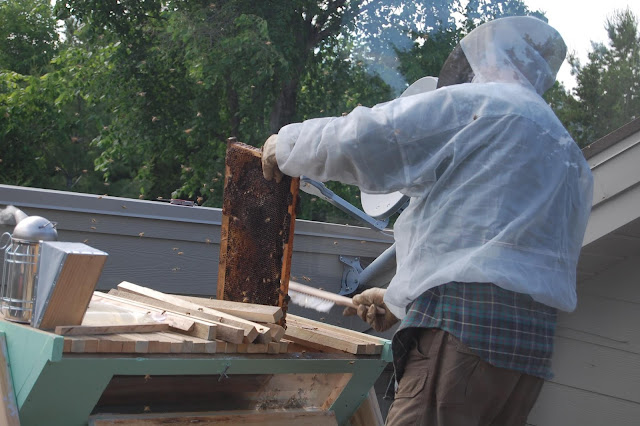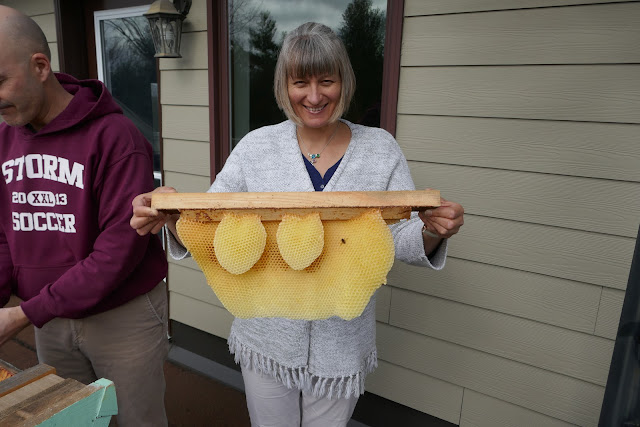Thursday, 9 May 2019
Raising Honey Bees
Spring is here again, thank heavens, so its time to post another project on my blog that I thought might interest you. I know spring has arrived when our goose pair return again to the great white north. This has been on the same date in April for the past 4 years!! Can you imagine the natural program that allows for that sort of accuracy.
The project I wish to tell about concerns the raising of honey bees.
I have been raising them for the past 4 years, which has been a very interesting experience. The impetus to do so came from our daughter Jenifer, who was raising bees in her yard at home in Seattle, Washington. She was housing them in a top bar hive, as apposed to the standard Langstroth hive that most apiarists use -- the white boxes you often see from the highway. Thus I built two top bar hives and installed them on our third level porch well away from the bears and raccoons. Once constructed, the basic hives (below) look like water troughs. Note the top bars and the spacer on the top or right of the picture and the glass window on the left side of the trough, which opens for viewing the inside of the hive where the bees will be located. The roof of the hive is seen in a picture below.
The bars that cover the top of the hive look like the single bar shown below, and the angular ridge on the down side of the bar is where the bees will begin naturally hanging their wax combs (shown later) when it is positioned on the top of the trough with the others like the 4 to the left of my arm.
And now the two hives with their removable roofs in place.
After building the hives, I ordered order two 'packages' of bees from our local apiarist, about 60 miles south of here. I picked them up and drove home with them in their cardboard boxes, and then installed them. The installation involved bathing them in mild smoke and lightly spraying them with sugary water, which calms them. They were then literally dumped into the two hive troughs, shown in the next several pictures, before covering the trough with the 21 top bars and the roof.
Note the 'smoker' on the top left of the trough. Each hive received about 3,000 bees and each hive got one fertilized queen.
More of the same.
The bees were then dumped into the hive. Those bees that don't make it into the hive on the first iteration soon find the entrance and join the colony.
The queen arrived with them but in a tiny plastic cage, which was placed in the hive with the worker bees still attached to her little cage (in the picture). The worker bees cannot gain access to the queen (as they normal would feed her) until they chew through the sugar plug end, which I am holding. It takes the workers about 3 days to chew through the plug and gain access to her. This procedure is used to let the workers get used to her 'smell' (pheromone) as she becomes their new hive queen. Without the acclimation procedure, they would often kill a 'new' hive queen. The caged queen is seen below along with several workers who are looking to feed her as they crawl around on her cage in my hand.
After a few days, the workers gain access to her and free her, leaving the empty cage hanging in the hive, which I then retrieved and discarded.
Now its time for the bees to make combs and go about the business of filling them with honey. They also 'tell' the queen whether she should deposit a fertilized egg in each comb hole or not. If the egg is fertilized and if it is fed a marginal amount of royal jelly, it will become a worker bee (all females). On the other hand, if the egg is fed mostly royal jelly, which happens when the hive is preparing to 'swarm' or move to a new location (described later), it becomes a new queen.
If the egg is unfertilized, which the queen can do based on information from the workers, the larval bee will develop into a drone, or male. The drones are largely useless, unless they are needed to breed a new queen. They are larger than the workers and need to be fed by the workers, as they cannot feed themselves (know anyone like that?). After mating with a new queen, the drones die; or, if the workers determine that they are not necessary for breeding, they are not fed and die. Being a male in the hive is not the best deal.
However, being a queen is not a great deal either, as she must lay thousands of eggs each day, so that the hive can grow rapidly before the fall and the end of natural food!! And indeed the hive does grow at an incredible rate. The bees work all day and into the night. In doing so, the maturing workers progressively pass through several stages of work activity over the course of their several weeks of life. This work includes cleaning, feeding all of the larva, feeding the queen and the drones, building the combs, defending the hive, and foraging for food. All of this is very interactive, and a bit complicated so I won't bore you with the details, but is amazing to watch. If we humans were so well organized and productive, most of our social, political and natural problems would disappear.
The first thing for the workers to do is to build combs in which the queen will lay eggs. The workers attach combs to each 'bar'. As soon as the first comb is built, the workers gather and store pollen (protein) and nectar in them, which is turned into protein food and honey and stored in the comb, thus food for everyone. Below are pictures of new combs, the newest being the smaller ones that that will 'grow' with servicing into combs that fill the space from that top bar to the hive's wall and floor. Below is a closeup to show the beauty of the new comb, followed by a picture of daughter-law Tracey and son Jamie to give the new combs size perspective.
\
Jamie and Tracey and the bar with empty combs. Note the precision of the cells in this and the last and next pictures.
Below, through the glass window in the hive, you can see the bees building and serving the new but empty combs.
And now to take a brief break and show you a picture of one of my pond rainbow trout for my fisherman friends.
Back to the bees.
Once the hive is really buzzing, the bees can cover the entrance with their comings and goings. This includes the to and fro foragers, the bee recipients of their bounty, and the entrance guards.
As the workers fill the combs, you can see their bounty by looking through the side window. In the picture below you can see the old filled combs to my right and the new ones at the far left.
A close up picture of these combs shows the honey in the combs against the glass. The two combs on the left are being filled with honey while those to the right are mostly already filled; the worker bees are everywhere.
A closer view of the entrance and the interactive activity.
On a hot day, when the hive is full, the temperature in the hive is elevated, and the bees will often hang around the opening all night in an attempt to cool off. Later in the summer, when the hive has grown enormously, the bee activity can become frenetic.
When you see this sort of activity, it appears the hive family has grown too big, and the workers have decided that they and the queen should leave half of the hive family intact, but the rest should 'swarm' and go find a new area for a new hive. Here you see the beginning of the bee gathering on the hive before the swarm takes flight.
About half of the workers, along with the old queen, take off into the air and look for a new temporary site called a 'bivouac'. In this particular example, they have chosen a large white pine 50 meters from our house (and their former hive). Note that they just hang in the air near the new temporary site for some time before making a final decision on the bivouac site.
Once the selection has been made, the workers gather here in a dense group and surround the queen up in the tree. At this time they are very docile. You may have seen pictures of apiarists at this time holding a swarm in their bare hands, or wearing them on their face like a beard! To get a better view of the bivouac, I put my 25 foot ladder up into the tree and got closer to the action, with no negative effect.
And higher and closer to the bivouac.
And finally, I am part of the group. Of course, they hang onto each other to form the ball.
Two days later, the bee scouts found a 'suitable' new location for a hive, and the group disappeared.
Actually they disappeared in two different groups separated by a day. They must have originally swarmed with two queens, and needed to find two new hive locations. Apparently this happens frequently. Now the remaining workers and new queen at our house hive must try to increase their numbers sufficiently to survive our deadly winter. To help them with this task, I built an insulated box into which I could place the hive in November. Note the little heater unit on the floor, which was set at a level only to keep them from a DEEP freeze. Although they are remarkably temperature tolerant, they cannot survive getting wet too.
And thus they are ready to go to spring.
If they survive the winter - great. If not, I remove the honey from the combs by crushing the combs in a clean bucket (below) and then filtering it through cheese cloth to extract the honey.
and from it make and bottle mead. That is not entirely a bad deal.
And here's to you amigos...
Subscribe to:
Post Comments (Atom)





























At first i thought the bottles were of honey!
ReplyDeleteNot so Jamie. Do think that Rob wants some more?
DeleteThat's really awesome Dan. Great photos. Your explanations are so clear, like you had been a professor or something.
ReplyDeleteAnd nice rainbow!
Paul
Thanks for the comments Paul. Its rewarding to know that someone has read the posting!
ReplyDeleteGreat photos! Makes me miss my bees. We weren't lucky enough to entice a swarm, so maybe next year we will re-invest in a package of bees. Bee beard, bearding, is that you call it when they hang down from the hive entrance during hot weather! So very nifty to see. I love that you got to get up close to the bee ball after the swarm! So were the bees toast this spring?
ReplyDeleteHey Dan! Great blog! Finally got around to responding. It is all so fascinating and fearless! I have learned a lot! Thanks for sharing!
ReplyDeleteOH...this is Paula! :)
Delete